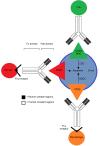How the discovery of rituximab impacted the treatment of B-cell non-Hodgkin's lymphomas
- PMID: 30881167
- PMCID: PMC6398399
- DOI: 10.2147/JBM.S190784
How the discovery of rituximab impacted the treatment of B-cell non-Hodgkin's lymphomas
Abstract
Non-Hodgkin's lymphoma (NHL) is the sixth-most common cancer in the UK, accounting for around 13,700 new cases every year. Until the late 1990s, treatment relied on intensive chemotherapy, such as CHOP (cyclophosphamide-doxorubicin HCl-vincristine [Oncovin]-prednisone). The use of standard CHOP therapy and its variations had resulted in poor five-year survival rates (as low as 26%), particularly in patients with aggressive NHL. Rituximab (Rituxan) was the first chimeric (mouse/human) monoclonal antibody approved for the treatment of NHL. It was approved by the US Food and Drug Administration in 1997 for indolent forms of NHL. It subsequently received EU approval in June 1998, and was licensed under the trade name Mabthera (Roche, Basel, Switzerland). It then went on to be approved for the first-line treatment of aggressive forms of NHL, such as diffuse large B-cell lymphoma (to be used in combination with CHOP or other anthracycline-based chemotherapy) in 2006. It is directed against the CD20 protein, an antigen found on the surface of B-cell lymphomas. With minimal toxicity, activity as a single-agent (for indolent forms of NHL) and safety when combined with chemotherapy (for aggressive forms), it represents great progress in this field. Here, we analyze how this antibody therapeutic was developed from basic molecular and cellular considerations through to preclinical and clinical evaluations and how it came to be a first-line treatment for NHL, and we discuss the impacts the advent of rituximab had on treatment outcomes for patients with DLBCL compared with the pre-rituximab era.
Keywords: B cell; monoclonal antibody; non-Hodgkin’s lymphoma; rituximab.
Conflict of interest statement
Disclosure The authors report no conflicts of interest in this work.
Figures


References
-
- Lipman NS, Jackson LR, Trudel LJ, Weis-Garcia F. Monoclonal versus polyclonal antibodies: Distinguishing characteristics, applications, and information resources. ILAR J. 2005;46(3):258–268. - PubMed
-
- Parham P. Antibody Structure and the Generation of B-Cell Diversity. In: Parham P, editor. The Immune System. 3rd ed. New York: Garland Science, Taylor & Francis Group; 2009. pp. 95–121.
-
- Rui L, Goodnow CC. Lymphoma and the control of B cell growth and differentiation. Curr Mol Med. 2006;6(3):291–308. - PubMed
Publication types
LinkOut - more resources
Full Text Sources
Research Materials

